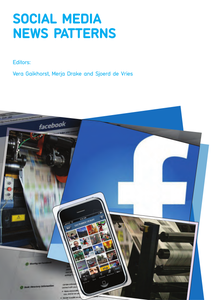This book provides a sample of studies and concepts created within the project Media ENriched Sport ExperienceS (MENSES). A project powered by Hilversum Media Campus, ZIGGO and Breda University of Applied Sciences. MENSES aims to create new media enriched sport experiences, by means of introducing innovative digital concepts combining media entertainment and live sport content. It wants to share building stones and blueprints to be accessed in Hilversum. As such it will help organizations to answer the question how live and broadcasted sport experiences can be enriched by means of new digital strategies. By combining interaction, transformation and data enrichment, the mediated and live sport events should be turned into a memorable sport experience
DOCUMENT

Een van de belangrijkste ontwikkelingen in het onderwijs is het gebruik van nieuwe kennismedia: media voor het genereren, begrijpen en delen van kennis. Denk aan social media, serious gaming, apps, tablets en smartphones. De grote vraag is: hoe ga je als school om met deze mediaontwikkelingen? In dit whitepaper presenteren we de roadmap van ons onderzoek naar de educatieve implementatie van de iPad (Engelstalig document)
DOCUMENT

Wereldwijd onderzoek: Hoe gebruiken nieuwsmedia social media? Jongeren lezen geen krant meer, ze kijken op hun smartphone die ze altijd bij de hand hebben. Binnen het lectoraat social media en reputatiemanagement van NHL hogeschool te Leeuwarden heeft een groep internationale studenten in 12 landen onderzoek gedaan. Hierbij hebben ze meer dan 150 social media sites bestudeerd van nieuws media. De resultaten maken deel uit van een internationaal onderzoek van NHL Hogeschool en Haaga Helia University. De onderzoeksvraag was: Wat speelt zich af in de nieuwsmedia? Persbureaus kunnen het overzicht gebruiken om hun social media te optimaliseren. En voor ieder die journalistiek een warm hart toedraagt is het interessante informatie over de nieuwsmedia in een overgangssituatie (2nd edition)
DOCUMENT

Developing and testing several AR and VR concepts for SAMSUNG (Benelux) Samsung and Breda University of Applied Sciences decided to work together on developing and testing several new digital media concepts with a focus on VR and gaming. This collaboration has led to several innovative projects and concepts, among others: the organisation of the first Samsung VR jam in which game and media students developed new concepts for SAMSUNG GEAR in 24 hours, the pre-development of a VR therapy concept (Fear of Love) created by CaptainVR, the Samsung Industry Case in which students developed new concepts for SAMSUNG GEAR (wearables), the IGAD VR game pitch where over 15 VR game concepts were created for SAMSUNG VR GEAR and numerous projects in which VR concepts are developed and created using new SAMSUNG technologies. Currently we are co-developing new digital HRM solutions.
The IMPULS-2020 project DIGIREAL (BUas, 2021) aims to significantly strengthen BUAS’ Research and Development (R&D) on Digital Realities for the benefit of innovation in our sectoral industries. The project will furthermore help BUas to position itself in the emerging innovation ecosystems on Human Interaction, AI and Interactive Technologies. The pandemic has had a tremendous negative impact on BUas industrial sectors of research: Tourism, Leisure and Events, Hospitality and Facility, Built Environment and Logistics. Our partner industries are in great need of innovative responses to the crises. Data, AI combined with Interactive and Immersive Technologies (Games, VR/AR) can provide a partial solution, in line with the key-enabling technologies of the Smart Industry agenda. DIGIREAL builds upon our well-established expertise and capacity in entertainment and serious games and digital media (VR/AR). It furthermore strengthens our initial plans to venture into Data and Applied AI. Digital Realities offer great opportunities for sectoral industry research and innovation, such as experience measurement in Leisure and Hospitality, data-driven decision-making for (sustainable) tourism, geo-data simulations for Logistics and Digital Twins for Spatial Planning. Although BUas already has successful R&D projects in these areas, the synergy can and should significantly be improved. We propose a coherent one-year Impuls funded package to develop (in 2021): 1. A multi-year R&D program on Digital Realities, that leads to, 2. Strategic R&D proposals, in particular a SPRONG/sleuteltechnologie proposal; 3. Partnerships in the regional and national innovation ecosystem, in particular Mind Labs and Data Development Lab (DDL); 4. A shared Digital Realities Lab infrastructure, in particular hardware/software/peopleware for Augmented and Mixed Reality; 5. Leadership, support and operational capacity to achieve and support the above. The proposal presents a work program and management structure, with external partners in an advisory role.
We live in a society that is increasingly dominated by technology-mediated interactions and consumption of experiences. It has opened pathways to innovative immersive technology concepts in the food and dining context, contributing to the development of a consumption-oriented society. This project addresses the challenge how to stimulate consumers through immersive technology designs to make conscious choices leading to more sustainable behaviors in the food and dining context. This project evolves around designing and testing Extended Reality (XR) technology-mediated immersive food experiences in the food and dining context to stimulate sustainable food consumption behavior. It includes the use of complementing measurement tools to test the effectiveness of XR designs to make better XR technology design choices that can stimulate change in consumption behavior.